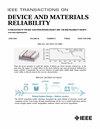钙钛矿/硅串联太阳能电池组件的亚稳态工作稳定性
IF 2.3
3区 工程技术
Q2 ENGINEERING, ELECTRICAL & ELECTRONIC
IEEE Transactions on Device and Materials Reliability
Pub Date : 2025-06-26
DOI:10.1109/TDMR.2025.3583339
引用次数: 0
摘要
近年来,钙钛矿/硅串联太阳能电池(PTSCs)的性能取得了显著的进步,显示出巨大的商业化潜力。然而,PTSC模块在实际工作条件下的操作稳定性仍然知之甚少。在本研究中,我们通过连接单个PTSCs来研究模块的稳定性。在PTSCs中首次观察到部分光遮挡引起的明显热点效应。此外,在最大功率点跟踪(MPPT)条件下,该模块的输出功率下降很快,但在黑暗环境下,该模块在1分钟内自动恢复到初始输出功率。令人印象深刻的是,经过几次MPPT循环后,模块的稳定性显著提高。这些发现为PTSC模块的稳定性机制提供了重要的见解,并为提高未来应用的性能提供了实用的指导。本文章由计算机程序翻译,如有差异,请以英文原文为准。
Metastable Operating Stability of Perovskite/Silicon Tandem Solar Cell Modules
The performance of perovskite/silicon tandem solar cells (PTSCs) has achieved remarkable progress in recent years, showing the great potential of commercialization. Nevertheless, the operational stability of PTSC modules under real working conditions remains poorly understood. In this study, we investigated the module stability by connecting individual PTSCs. Evident hot spot effect caused by partial light occlusion was firstly observed in PTSCs. Moreover, the module exhibited a rapid output power degradation under maximum power point tracking (MPPT) condition, but it spontaneously recovers to initial output power within one minute in dark environment. Impressively, the module stability improves significantly after several MPPT cycles. These findings provide critical insights into the stability mechanisms of PTSC modules and offer practical guidelines for improving the performance in future applications.
求助全文
通过发布文献求助,成功后即可免费获取论文全文。
去求助
来源期刊

IEEE Transactions on Device and Materials Reliability
工程技术-工程:电子与电气
CiteScore
4.80
自引率
5.00%
发文量
71
审稿时长
6-12 weeks
期刊介绍:
The scope of the publication includes, but is not limited to Reliability of: Devices, Materials, Processes, Interfaces, Integrated Microsystems (including MEMS & Sensors), Transistors, Technology (CMOS, BiCMOS, etc.), Integrated Circuits (IC, SSI, MSI, LSI, ULSI, ELSI, etc.), Thin Film Transistor Applications. The measurement and understanding of the reliability of such entities at each phase, from the concept stage through research and development and into manufacturing scale-up, provides the overall database on the reliability of the devices, materials, processes, package and other necessities for the successful introduction of a product to market. This reliability database is the foundation for a quality product, which meets customer expectation. A product so developed has high reliability. High quality will be achieved because product weaknesses will have been found (root cause analysis) and designed out of the final product. This process of ever increasing reliability and quality will result in a superior product. In the end, reliability and quality are not one thing; but in a sense everything, which can be or has to be done to guarantee that the product successfully performs in the field under customer conditions. Our goal is to capture these advances. An additional objective is to focus cross fertilized communication in the state of the art of reliability of electronic materials and devices and provide fundamental understanding of basic phenomena that affect reliability. In addition, the publication is a forum for interdisciplinary studies on reliability. An overall goal is to provide leading edge/state of the art information, which is critically relevant to the creation of reliable products.
 求助内容:
求助内容: 应助结果提醒方式:
应助结果提醒方式:


